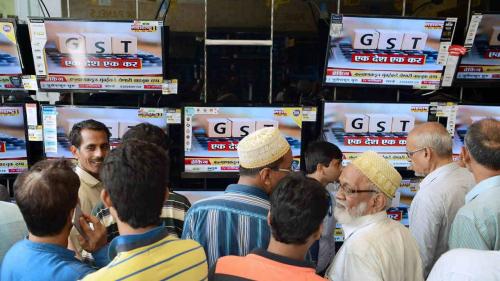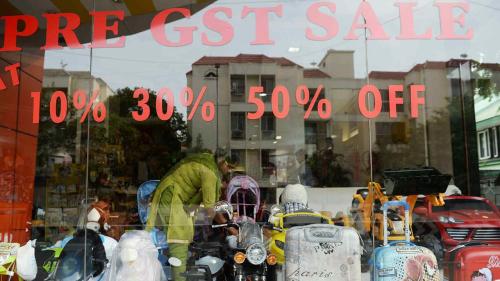The Indian government's new Goods and Services Tax (GST) took effect on July 1. The country now has five-tax system instead of the multiple state, local and national taxes it had.
Experts said that in the long-term the new tax will encourage smaller players to join the organized segment, leading to more revenues for the government.

Indians look at televisions displaying news on the new Goods and Services Tax (GST) regime at an electronic appliances showroom in Mumbai, India, June 30, 2017. /VCG Photo
The Goods and Services Tax (GST) is a value added tax. It replaces more than a dozen federal and state levies. That means India is finally a fiscal union, a common market, with a two trillion US dollar economy and 1.3 billion people.
Gold now faces a three percent tax under India's GST, which means more money coming out of buyers' pockets.
“The problem we have is that jewelers in smaller towns will take time to adjust to the paperwork. We are trying to help them with software that helps them upload invoices through their mobile phones,” said Manoj Kumar Jha, convener for Gems and Jewelry Federation of India.
But for the industry at large, the three percent increase came as a relief. That's because most industry lobbies were expecting a five percent levy. The tax rate on the manufacturing of jewelry was lowered to five percent from a previously proposed rate of 18 percent.
 An Indian laborer arranges products on display during a discount sale ahead of the forthcoming Goods and Services Tax (GST) in Chennai, India,June 28, 2017. /VCG Photo
An Indian laborer arranges products on display during a discount sale ahead of the forthcoming Goods and Services Tax (GST) in Chennai, India,June 28, 2017. /VCG Photo
Gold premiums in India jumped to their highest level in seven and a half months as consumers advanced purchases to avoid paying the higher tax. Analysts say a fear of the GST has propped up sales for retailers towards the end of June, and might lead to a lean period as both jewelers and customers adapt to the GST.
The government also introduced an input tax credit system under the GST. And firms will have an incentive to comply in order to avail credit for taxes already paid. This system would widen the tax net, shoring up public finances. Meanwhile, manufacturers could reclaim the taxes they paid when purchasing raw materials.
Even though the manufacturers need to pay taxes on output, the overall tax burden for them would be reduced eventually.
Therefore, industry groups only have concerns more about the paperwork, issues of compliance and the transition to GST.